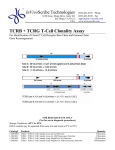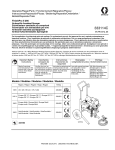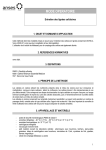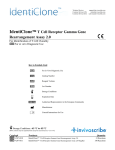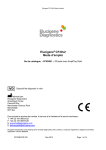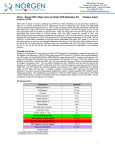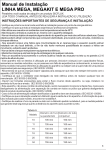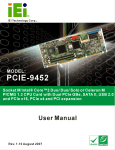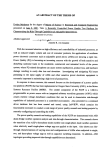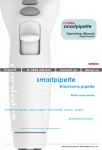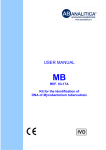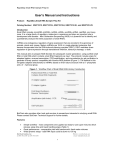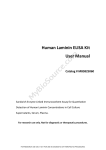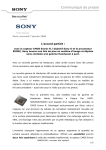Download IGH Gene Clonality Assay
Transcript
InVivoScribe Technologies 6330 Nancy Ridge Drive, Suite 106 San Diego, CA 92121 USA (858) 623-8105 – Phone (858) 623-8109 – Fax [email protected] www.invivoscribe.com IGH Gene Clonality Assay For Identification of Clonal Immunoglobulin Heavy Chain Gene Rearrangements FOR RESEARCH USE ONLY (Not for use in diagnostic procedures) Storage Conditions: -65ºC to -85ºC (DNA controls may be separated from assay kits and stored at 2°C to 8°C) Catalog# Products 1-101-0020 1-101-0021 1-101-0024 1-101-0040 1-101-0041 1-101-0044 IGH Gene Clonality Assay for Gel Detection IGH Gene Clonality Assay for ABI Fluorescence Detection IGH Gene Clonality Assay for Cy5.0 Detection IGH Gene Clonality Assay MegaKit for Gel Detection IGH Gene Clonality Assay MegaKit for ABI Fluorescence Detection IGH Gene Clonality Assay MegaKit for Cy5.0 Detection Quantity 33 Reactions 33 Reactions 33 Reactions 330 Reactions 330 Reactions 330 Reactions Page 2 of 18 Table of Contents 1. NOTICE .............................................................................................................................................................................. 3 2. PRINCIPLE ........................................................................................................................................................................ 3 3. ASSAY USES ...................................................................................................................................................................... 4 4. SPECIMEN REQUIREMENTS ....................................................................................................................................... 5 5. KIT CONTENTS ................................................................................................................................................................ 5 STATEMENT OF WARNINGS ............................................................................................................................................... 5 6. STORAGE CONDITIONS ................................................................................................................................................ 5 7. REAGENTS REQUIRED BUT NOT INCLUDED ......................................................................................................... 6 PCR AMPLIFICATION ................................................................................................................................................................. 6 ABI FLUORESCENCE DETECTION ............................................................................................................................................... 6 8. RECOMMENDED POSITIVE CONTROLS .................................................................................................................. 6 9. PROCEDURE NOTES ...................................................................................................................................................... 6 10. REAGENT PREPARATION ............................................................................................................................................ 7 11. SAMPLE PREPARATION ............................................................................................................................................... 7 12. AMPLIFICATION ............................................................................................................................................................. 7 13. DETECTION ...................................................................................................................................................................... 8 AVAILABLE TEMPLATE AMPLIFICATION CONTROLS .................................................................................................................. 8 GEL DETECTION – AGAROSE TBE GELS .................................................................................................................................... 8 GEL DETECTION – POLYACRYLAMIDE TBE GELS ...................................................................................................................... 8 GEL DETECTION – HETERODUPLEX ANALYSIS (RECOMMENDED) ........................................................................................ 8 ABI FLUORESCENCE DETECTION WITH ABI 310 & 3100 INSTRUMENTS .................................................................................... 9 ABI FLUORESCENCE DETECTION WITH ABI 373 & 377 INSTRUMENTS ...................................................................................... 9 CY5.0 FLUORESCENCE DETECTION ............................................................................................................................................ 9 14. INTERPRETATION AND REPORTING ....................................................................................................................... 9 EXPECTED SIZE OF AMPLIFIED PRODUCTS ............................................................................................................................... 10 SAMPLE INTERPRETATION ........................................................................................................................................................ 11 15. LIMITATIONS OF PROCEDURE ................................................................................................................................ 11 16. REFERENCES ................................................................................................................................................................. 11 17. APPENDIX ....................................................................................................................................................................... 12 REAGENTS AND SPECIAL SUPPLIES .......................................................................................................................................... 12 Ficoll Separation ................................................................................................................................................................ 12 Gel Electrophoresis ............................................................................................................................................................ 12 Differential Fluorescence Detection ................................................................................................................................... 12 18. TROUBLE SHOOTING GUIDE .................................................................................................................................... 12 19. SAMPLE DATA ............................................................................................................................................................... 13 OVERVIEW............................................................................................................................................................................ 13 GEL DETECTION ....................................................................................................................................................................... 14 ABI FLUORESCENCE DETECTION ............................................................................................................................................. 15 20. SINGLE PAGE FLOW CHART..................................................................................................................................... 18 GEL DETECTION – HETERODUPLEX ANALYSIS......................................................................................................................... 18 ABI FLUORESCENCE DETECTION WITH ABI 310 & 3100 INSTRUMENTS .................................................................................. 18 CY5.0 FLUORESCENCE DETECTION .......................................................................................................................................... 18 IGH Gene Clonality Assay FOR RESEARCH USE ONLY; not for use in diagnostic procedures 1101002Xv7.40 Page 3 of 18 Thank you for purchasing our IGH Gene Clonality Assay. We appreciate your business. We are happy to assist you in the validation of this assay, and will provide ongoing technical assistance to keep the assays performing efficiently in your laboratory. Technical assistance is most rapidly obtained using our Internet site: http://www.invivoscribe.com or by sending an email inquiry to: [email protected]. Questions received during business hours usually receive a response within an hour. Alternatively, you can call for technical assistance and for information on our testing kits at (858) 623-8105 between the hours of 8:00 AM and 5:00 PM Pacific Standard Time. 1. Notice This product and the methods employed are covered by United States Letters Patent Numbered 5,296,351 and 5,418,134; Australian Patent Number 626,601 and Japanese Patent Number 2,781,438, all of which are licensed exclusively to InVivoScribe Technologies (“IVS”). Purchase of this product includes a limited sublicense for non-commercial practice of this technology for use within (or with respect to data or product that are transmitted to) the United States, Japan or Australia only when the purchaser is registered with IVS as an exclusively non-commercial user of IVS products. No sublicense is granted simply by purchase of these products. Non-commercial practice of the technology means sample testing done for teaching and basic research. Non-Commercial practice excludes testing if any of the following apply: (a) test results, products or information derived from the tests are used for or in support of patient care, or are transferred to a healthcare professional involved in patient care; (b) test results are clinically utilized to determine cause of death; (c) compensation, in any form or manner, is received for performing the tests. To request a form for registration as an exclusively non-commercial product user, to discuss terms for a potential sublicense for broader practice of these methods, or for any questions concerning the scope or content of the non-commercial sublicense please contact our legal department by email at [email protected], or by telephone at (858) 623-8105. These methods also require nucleic acid amplification methods such as Polymerase Chain Reaction (PCR), which is covered by patents owned by Hoffmann-LaRoche, Inc. and F. Hoffmann-LaRoche Ltd. No license under these patents to use the PCR process is conveyed expressly or by implication to the purchaser by the purchase of these products. The assays described herein are not approved by any regulatory agency for clinical use. These assays are not for diagnostic or therapeutic use. This product is sold FOR RESEARCH USE ONLY; not for use in diagnostic procedures. 2. Principle NOTICE: InVivoScribe Technologies’ Gene Rearrangement and Translocation Assays represent a new approach to PCR-based clonality testing. These standardized assays were carefully optimized testing positive and negative control samples using multiplex master mixes. Assay development was followed by extensive validation testing more than 400 clinical samples using Revised European/American Lymphoma (REAL) Classification. Testing was done at more than thirty prominent independent testing centers throughout Europe in a collaborative study known as the BIOMED-2 Concerted Action. Results from this BIOMED-2 study appear in a leading peer-reviewed journal, Leukemia. 2003 Dec; 17(12):2257-2317 (Nature Publishing Group). BACKGROUND: Polymerase chain reaction (PCR) assays are routinely used for the identification of clonal B-cell populations. These tests amplify the DNA between primers that target the conserved framework (FR) and joining (J) regions (Tubes A-C), and the diversity (D) and joining regions (Tubes D & E). These conserved regions lie on either side of an area within the V-J region where programmed genetic rearrangements occur during maturation of all B and T lymphocytes. The antigen receptor genes that undergo rearrangement are the immunoglobulin heavy IGH Gene Clonality Assay 1101002Xv7.40 FOR RESEARCH USE ONLY; not for use in diagnostic procedures Page 4 of 18 chain & light chains genes in B-cells, and the T cell receptor genes in T-cells. Each B- and T-cell has a single productive V-J rearrangement that is unique in both length and sequence. Therefore, when this region is amplified using DNA primers that flank this region, a clonal population of cells yields one or two prominent amplified products (amplicons) within the expected size range. Two products are produced in cases when the initial rearrangement was non-productive and was followed by rearrangement of the other homologous chromosome. In contrast, DNA from a normal or polyclonal (many clones) population produces a bell-shaped curve of amplicon products (Gaussian distribution) that reflect the heterogeneous population of V-J region rearrangements. Since the antigen receptor genes are polymorphic (consisting of a heterogeneous population of related DNA sequences), it is difficult to employ a single set of DNA primer sequences to target all of the conserved flanking regions around the V-J rearrangement. N-region diversity and somatic mutation further scramble the DNA sequences in these regions. Therefore multiplex master mixes, which target several FR regions, are required to identify the majority of clonal rearrangements. As indicated, clonal rearrangements are identified as prominent, single-sized products within the smear of different-sized amplicon products that form a Gaussian distribution around a statistically favored, average-sized rearrangement. As expected, primers that amplify from the different FR regions, which are located at three distinct regions along the heavy chain gene, produce a correspondingly different size-range of V-J products. Gel electrophoresis is commonly used to resolve the different-sized amplicon products and ethidium bromide or other DNA intercalating dyes to stain and detect these products. A powerful alternative method is use of differential fluorescence detection with primers conjugated with fluorescent dyes that correspond to different targeted regions. Reaction products from several different master mixes can be pooled, fractionated using capillary electrophoresis, and detected simultaneously. This detection system results in unsurpassed sensitivity, single base resolution, differential product detection and relative quantification. In addition, the laboratory can eliminate the use of agarose and polyacrylamide gels, as well as the use of carcinogens such as ethidium bromide. Further, differential detection allows accurate, reproducible and objective interpretation of primerspecific products and automatic archiving of data. The limit of detection of this assay has been determined to be approximately 1 clonal cell in 100 hundred normal cells, and inter-assay and intra-assay reproducibility in size determination using capillary electrophoresis is approximately 1-2 basepairs. This reproducibility and sensitivity allows monitoring and tracking of individual tumors during research or methods development. The automatic archiving of specimen data allows comparison of data collected at different times. This test kit includes 6 master mixes. Tubes A, B, and C target the framework 1, 2, and 3 regions (respectively) within the variable region, and the joining region of the Ig heavy chain locus. Tubes D & E target the diversity and joining regions. The last master mix, the Specimen Control Size Ladder, targets multiple genes and generates a series of amplicons of 100, 200, 300, 400, and 600 base pairs to ensure that the quality and quantity of input DNA is adequate to yield a valid result. A single thermocycler program and similar detection methodologies are used with all of the BIOMED tests. Many of our customers have remarked that this improves consistency and facilitates cross training on a broad range of different assays. These robust InVivoScribe assays can be used to test DNA extracted from virtually any source. 3. Assay Uses Immunoglobulin Heavy Chain Gene Rearrangement Assays are useful for: Identifying clonal B-cell populations highly suggestive of B-cell malignancies Lineage determination of leukemias and lymphomas Monitoring and evaluation of disease recurrence Detection and assessment of residual disease Evaluation of new research and methods in malignancy studies IGH Gene Clonality Assay FOR RESEARCH USE ONLY; not for use in diagnostic procedures 1101002Xv7.40 Page 5 of 18 4. Specimen Requirements This assay tests genomic DNA 1. 5cc of peripheral blood, bone marrow biopsy, or bone marrow aspirate anti-coagulated with heparin or EDTA. Ship at ambient temperature; OR 2. Minimum 5mm cube of tissue shipped frozen; or at room temperature or on ice in RPMI 1640; OR 3. 2μg of genomic DNA; OR 4. Formalin-fixed paraffin embedded tissue or slides. 5. Kit Contents Controls and Standards IVS-0030 Clonal Control DNA IVS-0019 Clonal Control DNA IVS-0024 Clonal Control DNA IVS-0008 Clonal Control DNA IVS-0000 Polyclonal Control DNA Master Mixes IVS Catalog # 4-088-1750 4-088-1090 4-088-1390 4-088-0430 4-092-0010 IVS Catalog # Concentration 100μl @ 200μg/ml 100μl @ 200μg/ml 100μl @ 200μg/ml 100μl @ 200μg/ml 100μl @ 200μg/ml Target IGH Tube A IGH Tube B IGH Tube C IGH Tube D IGH Tube E Specimen Control Size Ladder 2-101-001X Framework 1 + JH 2-101-002X Framework 2 + JH 2-101-003X Framework 3 + JH 2-101-004X DH1-6 + JH 2-101-005X DH7 + JH 2-096-002X Multiple Genes Note: X = Detection format code Note: MegaKits contain 10 units of each master mix and 5 units of each Controls and Standards STATEMENT OF WARNINGS The assay kit has been optimized to be used as a system. Do not substitute other manufacturer’s reagents. Dilution, reducing amplification reaction volumes, or other deviation in this protocol may affect the performance of this test and/or nullify any limited sublicense that comes with the purchase of this testing kit. Close adherence to the protocol will assure optimal performance and reproducibility. It is recommended that glass distilled de-ionized molecular biology grade water be used with the preparation of specimen DNA. This can be purchased from several manufacturers. In addition, laboratory personnel are reminded to wear appropriate personal protective equipment and follow good laboratory practices and universal precautions when working with specimens. Specimens should be handled in approved biological safety containment facilities and opened only in certified biological safety cabinets. Please see Section 9 for further details. 6. Storage Conditions PCR master mixes are sensitive to freeze/thaw cycles. Therefore, for any duration other than immediate use, our master mixes and assay kits should be stored at -65°C to -85°C. The reason for this is quite straightforward: Due to the high salt concentrations in our master mixes, the effective freezing and thawing temperature of the master mixes is approximately –10°C. The temperature in a standard laboratory –20°C freezer can easily reach –10°C or warmer during the day when these freezers are opened on a regular basis. At these temperatures, PCR master mixes may go through multiple freeze/thaw cycles, resulting in precipitation of the primers. Accordingly, to minimize the exposure of your master mixes to freeze/thaw cycles, IVS recommends that master mixes be stored at -65°C to -85°C. IGH Gene Clonality Assay 1101002Xv7.40 FOR RESEARCH USE ONLY; not for use in diagnostic procedures Page 6 of 18 Please note that our DNA standards are best stored at 2°C to 8°C. However, these standards can be stored at any lower temperature as long as they are vortexed after thawing and before use to ensure that they are resuspended completely. If you have any questions, please contact our technical staff. We are happy to help you determine your optimal storage needs. 7. Reagents Required But Not Included PCR Amplification AmpliTaq Gold DNA Polymerase (RECOMMENDED) AmpliTaq DNA Polymerase (Applied Biosystems, Cat# N808-0241) (Applied Biosystems, Cat# N808-0161) ABI Fluorescence Detection HI-DI Formamide with ROX size standards - ABI 310 HI-DI Formamide with ROX size standards - ABI 3100 (IVS, Cat# 6-098-0051) (IVS, Cat# 6-098-0061) 8. Recommended Positive Controls Master Mix Target Color Control DNA Catalog # Product Size in Basepairs IGH Tube A FR1-JH Blue IGH Tube B FR2-JH Black IGH Tube C FR3-JH Green IGH Tube D DH-JH Green IGH Tube E DH7-JH Blue Specimen Control Size Ladder Multiple Blue Genes Valid Size Range IVS-0030 Clonal Control DNA Valid Size Range IVS-0030 Clonal Control DNA Valid Size Range IVS-0019 Clonal Control DNA Valid Size Range IVS-0024 Clonal Control DNA Valid Size Range IVS-0008 Clonal Control DNA Valid Size Range IVS-0000 Polyclonal Control DNA --4-088-1750 --4-088-1750 --4-088-1090 --4-088-1390 --4-088-0430 --4-092-0010 310-360 2801, 326 250-295 260 100-170 145 110-290, 390-420 139 100-1302 109 84, 96, 200, 300, 400, 6003 84, 96, 200, 300, 400, 600 Note: Note 1: Note 2: Note 3: The amplicon sizes listed above were determined using an ABI 3100 platform. Amplicon sizes seen on your specific CE instrument may differ 1-4bp from those listed above depending on the platform of detection (ABI) and the version of the analysis software used. Once identified, the amplicon size as determined on your specific platform will be consistent from run to run. This reproducibility is extremely useful when tracking MRD. A 280bp band may also be present and is a known amplicon that lies just outside the valid size range for IGH Tube A. A 209bp PCR product represents the smallest background band derived from the germline DH7-JH1 region. When the PCR amplification is very efficient, longer products might also be obtained because of primer annealing to downstream JH gene rearrangements; e.g. 416bp (DH7JH2), 1028bp (DH7-JH3), etc. Because smaller PCR fragments are preferentially amplified, it is not unusual for the 600bp fragment to have a diminished signal or to be missing entirely. 9. Procedure Notes Autoclaving does not eliminate DNA contamination. Work flow in the PCR laboratory should always be in a one way direction between separate work areas; beginning in Master Mix Preparation, moving to the Specimen Preparation, then to the Amplification, and finally to Detection. 1. Do not bring amplified DNA into the areas designated for master mix or specimen preparation. 2. Due to the analytical sensitivity of this test, extreme care should be taken to avoid the contamination of reagents or amplification mixtures with samples, controls or amplified materials. All reagents should be closely monitored for signs of contamination (e.g., negative controls giving positive signals). Discard reagents suspected of contamination. 3. All pipettes, pipet tips, and any equipment used in a particular area should be dedicated to and kept to that area of the laboratory. IGH Gene Clonality Assay FOR RESEARCH USE ONLY; not for use in diagnostic procedures 1101002Xv7.40 Page 7 of 18 4. PCR trays, bases, and retainers must to be decontaminated in 10% bleach and rinsed with distilled water two separate times before returning them to the starting areas. 5. Sterile, disposable plastic ware should be used whenever possible to avoid RNase or cross-contamination. 10. Reagent Preparation All unknown samples should be tested using the template amplification control (Amplification Control or Specimen Control Size ladder) master mix. This is to ensure that no inhibitors of amplification are present, and there is DNA of sufficient quality and quantity to generate a valid result. All samples should be tested in singlicate. Positive, negative and no template controls should be tested for each of the master mixes. 1. Using gloved hands, remove the master mixes from the freezer. Allow the tubes to thaw; then gently vortex to mix. 2. In containment hood or dead air box remove an appropriate aliquot to clean, sterile microfuge tube (one tube for each of the master mixes). Aliquot volumes should be 45μl for each sample + 135μl (3 x 45µl) for the positive, negative and no template controls. We recommend adding an additional 20μl to correct for pipetting errors. 3. Add the appropriate amount of either AmpliTaq Gold or AmpliTaq DNA polymerase (0.25μl of either AmpliTaq Gold or AmpliTaq @ 5U/μl per 50μl total PCR reaction volume) to each of the master mixes and gently mix by inverting several times or gently vortexing. The master mixes are now ready for distribution to reaction tubes or plate, and addition of sample. 11. Sample Preparation Using any method of DNA extraction, extract the genomic DNA from unknown samples. Resuspend DNA to final concentration of 100μg - 400μg per ml in TE (10 mM Tris-HCl, 1mM EDTA, pH 8.0) or distilled water. This is a robust assay system. A wide range of DNA concentrations will generate a valid result. Therefore, quantifying and adjusting DNA concentrations is generally not necessary. Testing sample DNAs with the Amplification Control or Specimen Control Size Ladder master mix will ensure that DNA of sufficient quality and quantity was present to yield a valid result. 12. Amplification 1. Aliquot 45μl of the master mix/enzyme solutions into individual PCR wells or tubes. 2. Add 5μl of sample or control DNA to the individual tubes or wells containing the respective master mix reactions. Pipette up and down several times to mix. Amplify the reactions using the following PCR program We recommend the MJ Research PTC-100, PTC-200 or the PE 2600, 9600, or 9700 thermocyclers, using the following PCR parameters for the amplifications: Note: We recommend using the calculated option for temperature measurement with the PTC instruments. Standard Program for AmpliTaq Gold Step 1: 95°C for 7 minutes Step 2: 95°C for 45 seconds Step 3: 60°C for 45 seconds Step 4: 72°C for 90 seconds Step 5: Go to step 2; 34 more times Step 6: 72°C for 10 minutes Step 7: 15°C forever IGH Gene Clonality Assay 1101002Xv7.40 FOR RESEARCH USE ONLY; not for use in diagnostic procedures Page 8 of 18 Remove the amplification plate from the thermocycler 13. Detection Not all detection formats are available for all assays Available Template Amplification Controls The Amplification Control master mix primers are labeled with a fluorescent dye (6-FAM or Cy5.0). This label is detected as BLUE using the differential fluorescence software. The amplicons produced with this master mix are at 235 basepairs. The products of this master mix should be run separately. The Specimen Control Size Ladder master mix primers are labeled with a fluorescent dye (6-FAM or Cy5.0). This label is detected as BLUE using the differential fluorescence software. The amplicons produced with this master mix are at ~100, 200, 300, 400, and 600 basepairs. Please note that the ~100bp band is comprised of a 84bp and 96bp bands. Both of these bands co-migrate on a gel. The products of this master mix should be run separately. Gel Detection – Agarose TBE Gels 1. A 2% MetaPhor or NuSieve 3:1 agarose/TBE gel is prepared. 2. 20μl from each of the amplification reactions are individually mixed with 4μl of 6X gel loading buffer. 20μl of this mixture is loaded into separate wells of the gel, flanked by DNA size standards. Products are detected using ethidium bromide or an equivalent dye. 3. Gel is photographed and data are interpreted. Gel Detection – Polyacrylamide TBE Gels 1. Assemble electrophoresis unit using a 6% non-denaturing polyacrylamide TBE gel (made with 1X TBE, Invitrogen Cat# EC62652Box) and 0.5X TBE running buffer (Invitrogen 5X TBE Cat# LC6675). 2. Add 5μl of ice-cold non-denaturing bromophenol blue loading buffer to samples. 3. Load 20μl of mixture into wells of the gel. 4. Run gel at 110V for 2-3 hours or 40-50V overnight. Voltage and electrophoresis time depend on the PCR amplicon size, acrylamide gel thickness, and type of PCR equipment. Voltage and run time can be adapted accordingly. 5. Gels are stained in 0.5μg/ml EtBr (in water or 0.5X TBE Buffer) for 5-10 minutes. 6. Gels are destained 2X in water for 5-10 minutes. 7. UV illumination is used for visualization. 8. Gel is photographed and data are interpreted. Gel Detection – Heteroduplex Analysis (RECOMMENDED) 1. Denature 20μl of PCR products at 94ºC for 5 minutes. 2. Re-anneal PCR products at 4ºC for 60 minutes. 3. Assemble electrophoresis unit using a 6% non-denaturing polyacrylamide TBE gel (made with 1X TBE, Invitrogen Cat# EC62652Box) and 0.5X TBE running buffer (Invitrogen 5X TBE Cat# LC6675). 4. Add 5μl of ice-cold non-denaturing bromophenol blue loading buffer to samples 5. Load 20μl of mixture into wells of the gel. 6. Run gel at 110V for 2-3 hours or 40-50V overnight. Voltage and electrophoresis time depend on the PCR amplicon size, acrylamide gel thickness, and type of PCR equipment. Voltage and run time can be adapted accordingly. 7. Gels are stained in 0.5μg/ml EtBr (in water or 0.5X TBE Buffer) for 5-10 minutes. 8. Gels are destained 2X in water for 5-10 minutes. 9. UV illumination is used for visualization. 10. Gel is photographed and data are interpreted. IGH Gene Clonality Assay FOR RESEARCH USE ONLY; not for use in diagnostic procedures 1101002Xv7.40 Page 9 of 18 ABI Fluorescence Detection with ABI 310 & 3100 instruments 1. Add 1μl of reaction products from the IGH Tubes A, B, and C (IGH FR1, 2, and 3, respectively) in separate tubes and add 10μl of HI-Deionized Formamide containing ROX size standards to the tube. Mix well. 2. Add 1μl of reaction products from the IGH Tube D in a separate tube and add 10μl of HI-Deionized Formamide containing ROX size standards to the tube. Mix well. 3. Add 1μl of reaction products from the IGH Tube E in a separate tube and add 10μl of HI-Deionized Formamide containing ROX size standards to the tube. Mix well. 4. Add 1μl of reaction product from the template amplification control in a tube and add 10µl of HIDeionized Formamide containing ROX size standards. Mix well. 5. Reaction products are heated to 95ºC for 2 minutes then snap chilled on ice for 5 minutes. 6. A sample sheet and injection list is made up for the samples. As the samples are run on the machine, they are fractionated, detected and analyzed by the instrument. Runs are 20-24 minutes in duration. The 310 & 3100 capillary electrophoresis instruments routinely handle 2 runs per hour (48 and 768 samples per day, respectively), and automatically analyze and store data for review or comparison with other test results. 7. Data are automatically displayed as size and color specific peaks. Review profile and controls, report results. ABI Fluorescence Detection with ABI 373 & 377 instruments 1. PCR Product Dilution: Initially dilute samples 1:10 in HI-Deionized Formamide or water (can be altered if the fluorescence signal is outside the optimal range). 2. Add 2μl of diluted reaction product from IGH Tube A in a tube + 2μl of HI-Deionized Formamide containing + 0.5μl of ROX size standards + 0.5µl of blue Dextran loading dye. Mix well. 3. Add 2μl of diluted reaction product from IGH Tube B in a tube + 2μl of HI-Deionized Formamide containing + 0.5μl of ROX size standards + 0.5µl of blue Dextran loading dye. Mix well. 4. Add 2μl of diluted reaction product from IGH Tube C in a tube + 2μl of HI-Deionized Formamide containing + 0.5μl of ROX size standards + 0.5µl of blue Dextran loading dye. Mix well. 5. Add 2μl of diluted reaction product from IGH Tube D in a tube + 2μl of HI-Deionized Formamide containing + 0.5μl of ROX size standards + 0.5µl of blue Dextran loading dye. Mix well. 6. Add 2μl of diluted reaction product from IGH Tube E in a tube + 2μl of HI-Deionized Formamide containing + 0.5μl of ROX size standards + 0.5µl of blue Dextran loading dye. Mix well. 7. Add 2μl of diluted reaction product from the template amplification control in a tube + 2μl of HI-Deionized Formamide containing + ROX size standards + 0.5µl of blue Dextran loading dye. Mix well. 8. Reaction products are heated to 94ºC for 2 minutes then snap chilled on ice for 5 minutes. 9. Load the 5μl of each of these preparations in separate wells of a preheated gel and run using the standard sequencing protocol. Cy5.0 Fluorescence Detection The Cy5.0 fluorochrome is capable of being detected by many different detection platforms. Please see your instruments user manual for instructions on the fractionation and detection of your samples. 14. Interpretation and Reporting Note: This assay is for research use only. Although positive results are highly suggestive of malignancy, these assays are designed for Research Use Only and, if used in a clinical setting, should only be used in support of diagnosis. Positive and negative results should be interpreted in the context of all clinical information and laboratory test results. PCR based testing does not identify 100% of clonal cell populations; therefore, repeat testing by Southern blot may be advisable to rule out clonality. The size range for each of the master mixes has been determined testing positive control samples. For accurate and meaningful interpretation it is important to ignore peaks that occur outside of the proscribed/valid size range for each of the master mixes. Peaks that are outside of the range cannot be assumed to be valid. IGH Gene Clonality Assay 1101002Xv7.40 FOR RESEARCH USE ONLY; not for use in diagnostic procedures Page 10 of 18 Note: “Color” indicates the color of products generated with the master mix when using differential fluorescence detection format (e.g., ABI instruments). Expected Size of Amplified Products Master Mix Target Color Control DNA IGH Tube A FR1-JH Blue IGH Tube B FR2-JH Black IGH Tube C FR3-JH Green IGH Tube D DH-JH Green IGH Tube E DH7-JH Blue Specimen Control Size Ladder Multiple Genes Blue Valid Size Range IVS-0000 Polyclonal Control DNA IVS-0030 Clonal Control DNA IVS-0019 Clonal Control DNA IVS-0024 Clonal Control DNA IVS-0008 Clonal Control DNA Valid Size Range IVS-0000 Polyclonal Control DNA IVS-0030 Clonal Control DNA IVS-0019 Clonal Control DNA IVS-0024 Clonal Control DNA IVS-0008 Clonal Control DNA Valid Size Range IVS-0000 Polyclonal Control DNA IVS-0030 Clonal Control DNA IVS-0019 Clonal Control DNA IVS-0024 Clonal Control DNA IVS-0008 Clonal Control DNA Valid Size Range IVS-0000 Polyclonal Control DNA IVS-0030 Clonal Control DNA IVS-0019 Clonal Control DNA IVS-0024 Clonal Control DNA IVS-0008 Clonal Control DNA Valid Size Range IVS-0000 Polyclonal Control DNA IVS-0030 Clonal Control DNA IVS-0019 Clonal Control DNA IVS-0024 Clonal Control DNA IVS-0008 Clonal Control DNA Any Human DNA Cat# --4-092-0010 4-088-1750 4-088-1090 4-088-1390 4-088-0430 --4-092-0010 4-088-1750 4-088-1090 4-088-1390 4-088-0430 --4-092-0010 4-088-1750 4-088-1090 4-088-1390 4-088-0430 --4-092-0010 4-088-1750 4-088-1090 4-088-1390 4-088-0430 --4-092-0010 4-088-1750 4-088-1090 4-088-1390 4-088-0430 --- Product Size in basepairs 310-360 851, 310-360 2802, 325 345 342 --250-2956 250-295 260 285 277 --100-170 100-170 --145 140 --110-2904, 390-420 235-258, 3443 744, 944, 1584, 1764, 1874, 2004, 3444 744, 944, 1584, 1764, 1874, 2004, 3444 139 744, 944, 1584, 1764, 1874, 2004, 3444 100-130 2095, 4165 794, 1234 794, 1234 794, 1234 109 84, 96, 200, 300, 400, 600 Note: The amplicon sizes listed above were determined using an ABI 3100 platform. Amplicon sizes seen on your specific CE instrument may differ 14bp from those listed above depending on the platform of detection and the version of the analysis software used. Once identified, the amplicon size as determined on your specific platform will be consistent from run to run. This reproducibility is extremely useful when tracking MRD. Note 1: Under sub-optimal conditions an aspecific product of 85bp can be detected in Tube A. To discriminate between specific and aspecific, negative control DNA should not show this band within the same experiment. If a band is present, we then consider the band specific. Note 2: The 280bp band is a known amplicon that lies just outside the valid size range for Tube A. Note 3: An aspecific 344bp band is the result of cross-annealing of the DH2 primer to a sequence in the region upstream of JH4. In GeneScan analysis, this band does not co-migrate with D-J products. Note 4: These bands are known amplicons that are seen with many different cell lines. These bands are absent in the presence of polyclonal backgrounds. Note 5: A 209bp PCR product represents the smallest background band derived from the germline DH7-JH1 region. When the PCR amplification is very efficient, also longer products might be obtained because of primer annealing to downstream JH gene rearrangements; e.g. 416bp (DH7-JH2), 1028bp (DH7-JH3), etc. Note 6: A non-specific peak may be seen at 227bp. Results can be reported as “Positive” or “Negative” for “Detection of clonal immunoglobulin heavy chain gene rearrangement consistent with the presence of a clonal cell population” 1. Samples that fail to amplify following repeat testing should be reported as “A result cannot be reported on this specimen because there was DNA of insufficient quantity or quality for analysis”. 2. It is acceptable to call a sample “Positive” when a product is generated in the valid size range yet the positive control for that master mix fails. 3. Samples that test negative should be repeated if the positive control reaction failed. IGH Gene Clonality Assay FOR RESEARCH USE ONLY; not for use in diagnostic procedures 1101002Xv7.40 Page 11 of 18 4. All assay controls must be examined prior to interpretation of sample results. If the controls do not yield the correct results, the assay is not valid and the samples should not be interpreted. The following describes the analysis of each of the controls, and the decisions necessary based upon the results. 1. Negative Control: (Polyclonal control, water or no template blank). If the negative control is: Positive: Possible contamination of all PCR amplification reactions. Do not continue with the interpretation of results. Prepare fresh master mix and repeat amplification. Negative: Continue with the analysis. 2. Positive Control: Positive: Negative: (This can also be an extraction control if positive control material is taken through extraction processes). If the positive control is: Continue with analysis. Repeat assay unless specimen tests positive. 3. Specimen Control Size Ladder: (This is run on unknown samples only). If the amplification control is: Positive: ~100, 200, 300, 400, and 600 basepair products are seen. Because smaller PCR fragments are preferentially amplified, it is not unusual for the 600 basepair fragment to have a diminished signal or to be missing entirely. Continue with analysis. Negative: Repeat assay unless specimen tests positive. Sample Interpretation Following the acceptance of the controls, the clinical samples are interpreted as follows: One or two prominent bands within the valid size range are reported as: “Detection of clonal immunoglobulin heavy chain gene rearrangement consistent with the presence of a clonal cell population.” 15. Limitations of Procedure The assay is subject to interference by degradation of DNA or inhibition of PCR due to heparin or other agents. The assay cannot reliably detect less than 1 positive cell per 100 normal cells. 16. References 1. 2. 3. Miller, JE, Wilson, SS, Jaye, DJ, Kronenberg, M. An automated semiquantitative B and T cell clonality assay. Mol. Diag. 1999, 4(2):101-117. van Dongen, JJM et al. Design and standardization of PCR primers and protocols for detection of clonal immunoglobulin and T-cell receptor gene recombinations in suspect lymphoproliferations: Report of the BIOMED-2 Concerted Action BMH4-CT98-3936. Leukemia. 2003, 17(12):2257-2317. van Krieken JH, Langerak AW, Macintyre EA, Kneba M, Hodges E, Sanz RG, Morgan GJ, Parreira A, Molina TJ, Cabeçadas J, Gaulard P, Jasani B, Garcia JF, Ott M, Hannsmann ML, Berger F, Hummel M, Davi F, Brüggemann M, Lavender FL, Schuuring E, Evans PA, White H, Salles G, Groenen PJ, Gameiro P, Pott Ch, van Dongen JJM. Improved reliability of lymphoma diagnostics via PCR-based clonality testing: report of the BIOMED-2 Concerted Action BHM4-CT98-3936. Leukemia. 2007; 21(2):201-6. IGH Gene Clonality Assay 1101002Xv7.40 FOR RESEARCH USE ONLY; not for use in diagnostic procedures Page 12 of 18 17. Appendix Reagents and Special Supplies Ficoll Separation Ficoll-Hypaque or Ficoll-Paque 1X PBS diluted from 10X PBS RPMI 1640 DMSO Hybri-Max Fetal Bovine Serum (Pharmacia, Cat# 17-0840-02) (Gibco/BRL, Cat# 70011-044) (Gibco/BRL, Cat# 11875-093) (Sigma, Cat# D2650) (Hyclone, Cat# SH30071.03) Gel Electrophoresis MetaPhor Agarose, 125g NuSieve 3:1 Agarose, 125g UltraPure™ 10 mg/ml Ethidium Bromide 10X BlueJuice™ Gel Loading Buffer Ready-LoadTM 100 bp Ladder Novex® TBE gels (6%, 12 well) Novex® TBE Running Buffer (5X) Novex® Hi-Density TBE Sample Buffer (5X) (Cambrex, (Cambrex, (Invitrogen, (Invitrogen, (Invitrogen, (Invitrogen, (Invitrogen, (Invitrogen, Differential Fluorescence Detection HI-DI Formamide with ROX size standards - ABI 310 HI-DI Formamide with ROX size standards - ABI 3100 HI-Deionized Formamide HI-Deionized Formamide GS ROX 50-400HD Size Standard (IVS, Cat# 6-098-0051) (IVS, Cat# 6-098-0061) (IVS, Cat# 6-098-0041) (Applied Biosystems, Cat# 4311320) (Applied Biosystems, Cat# 402985) Cat# 50180) Cat# 50090) Cat# 15585-011) Cat# 10816-015) Cat# 10380-012) Cat# EC62652Box) Cat# LC6675) Cat# LC6678) 18. Trouble Shooting Guide Our laboratories are located in San Diego, California. Technical assistance is most rapidly obtained using our Internet site: http://www.invivoscribe.com or by sending an email inquiry to: [email protected]. Alternatively, you can call (858) 623-8105 for technical assistance and information on our testing kits between the hours of 8:00 AM and 5:00 PM Pacific Standard Time. Questions received during business hours usually receive a response within an hour. IGH Gene Clonality Assay FOR RESEARCH USE ONLY; not for use in diagnostic procedures 1101002Xv7.40 Page 13 of 18 19. Sample Data OVERVIEW This is a diagrammatic representation of the immunoglobulin heavy chain gene on chromosome 14. The locations of the variable (V), diversity (D), joining (J), and constant (C) regions are indicated. The three conserved framework regions, FR1, FR2, and FR3, are color coded to match the fluorescent primers that are used to identify these regions using the ABI differential fluorescence detection method. IGH Gene Clonality Assay 1101002Xv7.40 FOR RESEARCH USE ONLY; not for use in diagnostic procedures Page 14 of 18 Gel Detection The data shown below were generated using the master mixes indicated. Amplified products were run on a 6% polyacrylamide gel. For each IGH master mix (Figures 1-5): Lane 1 displays data generated testing an alternative 100% clonal control DNA. Lane 2 displays data generated testing the recommended 100% clonal control DNA. Lane 3 displays data generated testing a 10% dilution of the recommended clonal control DNA. Lane 4 displays data generated testing IVS-0000 Polyclonal Control DNA. Figure 1 Figure 2 Figure3 Figure 4 IGH Gene Clonality Assay FOR RESEARCH USE ONLY; not for use in diagnostic procedures 1101002Xv7.40 Page 15 of 18 Figure 5 ABI Fluorescence Detection The data shown below were generated using the master mixes indicated. Amplified products were run on an ABI 3100 instrument. For each IGH master mix (Figures 6-10): Panel 1 displays data generated testing an alternative 100% clonal control DNA. Panel 2 displays data generated testing the recommended 100% clonal control DNA. Panel 3 displays data generated testing a 10% dilution of the recommended clonal control DNA. Panel 4 displays data generated testing IVS-0000 Polyclonal Control DNA. Figure 6 IGH Gene Clonality Assay 1101002Xv7.40 FOR RESEARCH USE ONLY; not for use in diagnostic procedures Page 16 of 18 Figure 7 Figure 8 IGH Gene Clonality Assay FOR RESEARCH USE ONLY; not for use in diagnostic procedures 1101002Xv7.40 Page 17 of 18 Figure 9 Figure 10 IGH Gene Clonality Assay 1101002Xv7.40 FOR RESEARCH USE ONLY; not for use in diagnostic procedures Page 18 of 18 20. Single Page Flow Chart 1. 2. 3. 4. 5. Using gloved hands, remove the master mixes from the freezer. Allow the tubes to thaw; then gently vortex to mix. In a containment hood or dead air box remove an appropriate aliquot to clean, sterile microfuge tube (one tube for each of the master mixes). Aliquot volumes should be 45μl for each sample + 135μl for the positive, negative and no template controls. We recommend adding an additional 20μl to correct for pipetting errors. Add the appropriate amount of either AmpliTaq Gold or AmpliTaq DNA polymerase (0.25μl of either AmpliTaq Gold or AmpliTaq @ 5U/μl per 50μl total PCR reaction volume) to each of the master mixes and gently mix by inverting several times or gently vortexing. Aliquot 45μl of master mix to individual wells of a PCR plate. Add 5μl of DNA from the unknown and control samples to individual tubes or wells containing the respective master mix reactions, and pipette up and down several times to mix. Amplify target DNA using the universal thermocycler program. Gel Detection – Heteroduplex Analysis 6. Denature 20μl of PCR products at 94ºC for 5 minutes. 7. Re-anneal PCR products at 4ºC for 60 minutes. 8. Assemble electrophoresis unit using a 6% non-denaturing polyacrylamide TBE gel (made with 1X TBE, Invitrogen Cat# EC62652Box) and 0.5X TBE running buffer (Invitrogen 5X TBE Cat# LC6675). 9. Add 5μl of ice-cold non-denaturing bromophenol blue loading buffer to samples 10. Load 20μl of mixture into wells of the gel. 11. Run gel at 110V for 2-3 hours or 40-50V overnight. Voltage and electrophoresis time depend on the PCR amplicon size, acrylamide gel thickness, and type of PCR equipment. Voltage and run time can be adapted accordingly. 12. Gels are stained in 0.5μg/ml EtBr (in water or 0.5X TBE Buffer) for 5-10 minutes. 13. Gels are destained 2X in water for 5-10 minutes. 14. UV illumination is used for visualization. 15. Gel is photographed and data are interpreted. ABI Fluorescence Detection with ABI 310 & 3100 instruments 6. Add 1μl of reaction products from IGH Tubes A, B, and C (IGH FR1, 2, and 3, respectively) in separate tubes and add 10μl of HIDeionized Formamide containing ROX size standards to each tube. Mix well. 7. Add 1μl of reaction products from IGH Tube D in a separate tube and add 10μl of HI-Deionized Formamide containing ROX size standards. Mix well. 8. Add 1μl of reaction products from IGH Tube E in a separate tube and add 10μl of HI-Deionized Formamide containing ROX size standards. Mix well. 9. Add 1μl of reaction product from the template amplification control in a tube and add 10µl of HI-Deionized Formamide containing ROX size standards. Mix well. 10. Reaction products are heated to 95ºC for 2 minutes then snap chilled on ice for 5 minutes. 11. A sample sheet and injection list is made up for the samples. As the samples are run on the machine, they are fractionated, detected and analyzed by the instrument. Runs are 20-24 minutes in duration. The 310 & 3100 capillary electrophoresis instruments routinely handle 2 runs per hour (48 and 768 samples per day, respectively), and automatically analyze and store data for review or comparison with other test results. 12. Data are automatically displayed as size and color specific peaks. Review profile and controls, report results. Cy5.0 Fluorescence Detection The Cy5.0 fluorochrome is capable of being detected by many different detection platforms. Please see your instruments user manual for instructions on the fractionation and detection of your samples. IGH Gene Clonality Assay FOR RESEARCH USE ONLY; not for use in diagnostic procedures 1101002Xv7.40



















